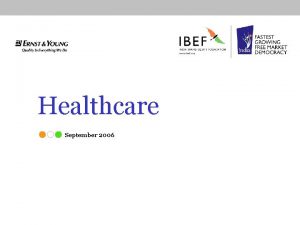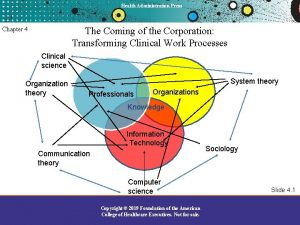Health Administration Press Strategic Analysis for Healthcare Chapter























- Slides: 23

Health Administration Press Strategic Analysis for Healthcare Chapter 15 Copyright © 2016 Foundation of the American College of Healthcare Executives. Not for sale.

Health Administration Press Life Cycle Analysis • Life cycle analysis assesses products, organizations, or industries by analyzing the current stage in their life cycle. • Although numerous life cycle models exist, researchers have generally identified five main phases in a life cycle: – Birth – Growth – Maturity – Revival – Decline Copyright © 2016 Foundation of the American College of Healthcare Executives. Not for sale.

Health Administration Press Life Cycle Analysis Copyright © 2016 Foundation of the American College of Healthcare Executives. Not for sale.

Health Administration Press Life Cycle Analysis: Birth • Organizations in the birth stage are attempting to establish for the first time a viable product-market strategy. • This is achieved mainly by trial and error as efforts are made to change products and services in a manner that generates distinctive competences. • This generally involves major and frequent product or service innovations and the conscious pursuit of a niche strategy. • Because companies in the birth phase are small and have no established reputation, they do not directly confront their more powerful competitors. • Instead, they find gaps, or niches, in the market that are not being filled, and they fill and defend these niches by making innovations. Copyright © 2016 Foundation of the American College of Healthcare Executives. Not for sale.

Health Administration Press Life Cycle Analysis: Birth Phase Situation Organization Innovation & Strategy Birth Phase: Small firm Informal structure Considerable innovation in product lines Young Undifferentiated Niche Strategy Dominated by owner/ manager Power highly centralized Substantial risk taking Homogenous/ placid environment Crude information processing & decision making methods Copyright © 2016 Foundation of the American College of Healthcare Executives. Not for sale.

Health Administration Press Life Cycle Analysis: Growth • The emphasis of the growth phase is growth and early diversification: – Product lines are broadened. – Efforts are also devoted to incrementally tailoring products to new markets. – Less stress is placed on major or dramatic product innovations. • “Market segmentation begins to play a role, with managers trying to identify specific subgroups of customers and to make small product or service modifications in order to better serve them. ” • “In other words, the niche strategy is often abandoned as broader markets are addressed. ” (Miller and Friesen 1948) Copyright © 2016 Foundation of the American College of Healthcare Executives. Not for sale.

Health Administration Press Life Cycle Analysis: Growth • Organizations in the growth phase are bigger and stronger than those in the birth phase, and they are better able to lobby with various levels of government. • They may also acquire subsidiaries in their efforts to diversify. – An acquisition of this nature “generally takes the form of buying out much smaller competing enterprises in the same industry rather than diversifying into new industries. ” – “The acquired firms are usually integrated into the functionally-based structure rather than left as independent divisions” (Miller and Friesen 1984). Copyright © 2016 Foundation of the American College of Healthcare Executives. Not for sale.

Health Administration Press Life Cycle Analysis: Growth Phase Situation Organization Innovation & Strategy Growth Phase: Medium sized Some formalization of structure Older Functional basis of organization Broadening of product-market scope into closely related areas Incremental innovation in product lines Multiple share holders Moderate differentiation Rapid growth A more heterogeneous & competitive environment Somewhat less centralized Copyright © 2016 Foundation of the American College of Healthcare Executives. Not for sale.

Health Administration Press Life Cycle Analysis: Maturity • Firms in the maturity phase are conservative, “do not perform many major innovations, engage in very few efforts at diversification or acquisition, and fail even to make many incremental changes to the products or services being offered. ” • “The tendency, more than in any other phase, is to follow the competition; to wait for competitors to lead the way in innovating and, then, to imitate the innovations if they prove to be necessary” (Miller and Friesen 1984). • Markets in the maturity phase are slightly broader than in the growth phase, and fewer firms opt for a niche strategy. • Firms try to arrange for a stable, negotiated environment by fixing prices and lobbying with the government. Copyright © 2016 Foundation of the American College of Healthcare Executives. Not for sale.

Health Administration Press Life Cycle Analysis: Maturity • The goal appears to be to improve the efficiency and profitability of operations. • This is achieved by – avoiding costly changes in product lines, – ensuring favorable prices via collusion, and – lobbying for barriers to foreign competition. • “A stable and circumscribed product line is sold in traditional markets, the emphasis being upon economical production and the preservation of sales volume” (Miller and Friesen 1984). Copyright © 2016 Foundation of the American College of Healthcare Executives. Not for sale.

Health Administration Press Life Cycle Analysis: Maturity Phase Situation Organization Innovation & Strategy Maturity Phase: Larger Formal, bureaucratic structure Consolidation of product- market strategy Even older Functional basis of organization Focus on efficiently supplying a well defined market Dispersed ownership Moderate differentiation Conservatism Heterogeneous & competitive environment Moderate centralization Slow growth Copyright © 2016 Foundation of the American College of Healthcare Executives. Not for sale.

Health Administration Press Life Cycle Analysis: Revival • The revival phase is in many ways the most exciting of the five. • Changes begin to take place in the product-market strategies being followed. • “For example, there are more major and minor productline and service innovations than in any other period. ” • “New markets are entered for the first time as firms become more diversified” (Miller and Friesen 1984). • This diversification sometimes involves the acquisition of firms in different industries. Copyright © 2016 Foundation of the American College of Healthcare Executives. Not for sale.

Health Administration Press Life Cycle Analysis: Revival • Market segmentation further defines discrete parts of the environment, and firms differentiate product lines accordingly. • “Essentially, firms experience dramatic diversification in their products and markets. Their growth does not simply result in an increase in size but an expansion of product-market scope. There is a movement from one market to many, reversing the stagnation of the maturity phase” (Miller and Friesen 1984). • Because of their size, market power, visibility, and occasional acquisitions, some firms in the revival phase lobby with the government to avoid interference with expansion, to obtain protection against imports, and to avoid antitrust lawsuits. Copyright © 2016 Foundation of the American College of Healthcare Executives. Not for sale.

Health Administration Press Life Cycle Analysis: Revival Phase Situation Organization Innovation & Strategy Revival Phase: Very large Divisional basis of organization Very heterogeneous, competitive, dynamic High differentiation Strategy of product- market diversification; movement into some unrelated markets High level of risk taking & planning Sophisticated control, scanning, and Substantial innovation communications in info. processing; more formal analysis in decision making Rapid growth Copyright © 2016 Foundation of the American College of Healthcare Executives. Not for sale.

Health Administration Press Life Cycle Analysis: Decline • Firms in the decline stage react to adversity in their markets by becoming stagnant. • “They try to conserve resources depleted by poor performance by abstaining from product or service innovation. Product lines are rendered antiquated so that it becomes necessary to cut prices to maintain sales” (Miller and Friesen 1984). Copyright © 2016 Foundation of the American College of Healthcare Executives. Not for sale.

Health Administration Press Life Cycle Analysis: Decline • Firms seem to be caught in a vicious circle: – “Their sales are poor because their product lines are unappealing. – This reduces profits and makes for scarcer financial resources, – which in turn cause any significant product line changes to seem too expensive” (Miller and Friesen 1984). • As a result, changes are avoided, and product lines become even more outdated. Copyright © 2016 Foundation of the American College of Healthcare Executives. Not for sale.

Health Administration Press Life Cycle Analysis: Decline Phase Situation Organization Innovation & Strategy Decline Phase: Market size Formal, bureaucratic structure Low level of innovation Homogeneous and competitive environment Mostly functional basis of organization Price cutting Moderate differentiation and Consolidation of product- market centralization Less sophisticated info processing Liquidation of subsidiaries systems and decision making methods Risk aversion & conservatism Slow growth Copyright © 2016 Foundation of the American College of Healthcare Executives. Not for sale.

Health Administration Press Life Cycle Analysis: Decline • Reasons for Decline – Too much debt 28% – Inadequate leadership 17% – Poor planning 14% – Failure to change 11% – Inexperienced management 9% – Not enough revenue 8% (Business Week 2003) – What do these reasons have in common? Copyright © 2016 Foundation of the American College of Healthcare Executives. Not for sale.

Health Administration Press Life Cycle / Competition Matrix • Dodge, Fullerton, and Robbins (1994) suggest a different way to consider the organizational life cycle. • First, they group organizations into either early stages of development or late stages of development. • They then consider the level of competition the organizations are experiencing. • The resulting four-block matrix displays common critical problems faced by companies in each block. • Strategies can be developed to address the critical problems. Copyright © 2016 Foundation of the American College of Healthcare Executives. Not for sale.

Health Administration Press Life Cycle / Competition Matrix Copyright © 2016 Foundation of the American College of Healthcare Executives. Not for sale.

Health Administration Press Life Cycle / Competition Matrix Copyright © 2016 Foundation of the American College of Healthcare Executives. Not for sale.

Health Administration Press Life Cycle / Competition Matrix • Note that the life cycle chart reflects Toyota, the parent company, and its divisions. • Even though Toyota overall is in maturity, some of its other divisions are still in the growth stage. • Overlaying the life cycle / competition matrix to the life cycle chart reveals that overall Toyota is in “late stage” life cycle with “intense competition. ” This suggests “critical problems” of (a) maintaining market position, (b) furthering its image via focus & differentiation strategies, and (c) cost control. Copyright © 2016 Foundation of the American College of Healthcare Executives. Not for sale.

Health Administration Press Exercise • Divide up into groups and create a life cycle chart for your project organization. Include the parent company and any divisions (if there any). • What are the implications for strategy? Copyright © 2016 Foundation of the American College of Healthcare Executives. Not for sale.
 Health administration press
Health administration press Healthcare and the healthcare team chapter 2
Healthcare and the healthcare team chapter 2 Sports medicine meaning
Sports medicine meaning Uncw healthcare administration
Uncw healthcare administration Uic healthcare administration
Uic healthcare administration Healthcare administration in athletic training
Healthcare administration in athletic training Healthcare administration definition
Healthcare administration definition Strategic analysis and choice in strategic management
Strategic analysis and choice in strategic management Strategic and operational planning in healthcare
Strategic and operational planning in healthcare School of public health monash
School of public health monash Health informatics george mason
Health informatics george mason University of central florida health care administration
University of central florida health care administration Veterans health administration organizational chart
Veterans health administration organizational chart Strategic fit vs strategic intent
Strategic fit vs strategic intent Complements and substitutes
Complements and substitutes Io model strategic management
Io model strategic management Chapter 19 section 3 freedom of speech and press
Chapter 19 section 3 freedom of speech and press Chapter 19 section 3 freedom of speech and press
Chapter 19 section 3 freedom of speech and press Townsend press chapter 4 implied main ideas
Townsend press chapter 4 implied main ideas Ariel imas
Ariel imas Chapter 3 health wellness and health disparities
Chapter 3 health wellness and health disparities Chapter 1 understanding health and wellness lesson 2
Chapter 1 understanding health and wellness lesson 2 Glencoe health chapter 1 understanding health and wellness
Glencoe health chapter 1 understanding health and wellness Fspos vägledning för kontinuitetshantering
Fspos vägledning för kontinuitetshantering











































